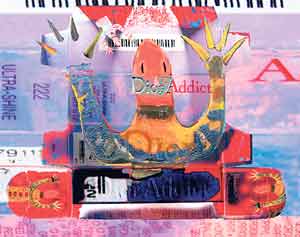| The vestibule of an image house in a Sri Lankan ‘viharaya’ usually serves as a starting point of the picture programme of the murals that follow in the sanctum. For Cora de Lang’s recent exhibition titled “Pandora’s Box”, the vestibule of the “Red Dot Gallery” was transformed by an installation using large canvases covering almost the entire expanse of the walls. Each canvas had its own theme and dominating colour: Red, yellow, green and blue placed in a sequence that gave depth to the limited space.
To most visitors the blast of colour in this room with details of symbolism and ornamentation, was overwhelming.
The symbols and references made to visual cultures of Latin America, where the artist was born, Africa, India, where the artist lived, made me ask a question, whether this was going to be another “world culture masala”. Having visited De Lang’s two previous exhibitions at the Barefoot Gallery (2006) and the Gallery Café (2007), I was confident that the many layers of imagery hidden in these mural -like panels would decode themselves in the other rooms of the gallery.
These themes and images are connected to De Lang’s personal experiences, creating her own mythology: Decorative details drawn from the world of trinkets and artifacts loaded with mythical associations point to her specific style seen at the previous exhibitions. Her early canvases had been packaging from her father’s factory in Buenos Aires, each box once used as packaging for cosmetics. When opened up, they reveal curious shapes to become the kind of canvas or medium to relate their own story.
The collage on paper titled “Hello Paradise” for example, has been based on the packaging of lipstick from “Dior Addict”. An African lizard with sharp gold metallic claws and red phallic head appears and reappears, beckoning the observer to paradise. The dominant colours, red and pink and the golden frame hint at the “paradise” the “ultra-shine” lipstick on the lips would offer to the consumer. Taking time with the exhibits allowed the visitor to discover the hidden layers of associations depending on the individual’s visual memory and fantasy.
Packaging of another type, “airsickness bags” collected on different flights became the medium in another room. The “airsickness bag” has been most unimaginative in design for years but for de Lang, each bag collected from a different airline is a trip crossing not only geographical but also cultural borders.
The “airsickness bag” titled “Sri Lankan Monk” had disturbed some visitors, who questioned why a sacred image had been used to decorate the bag. Maybe these visitors were unaware that the Buddha himself in the “Mahasatipattanasutta” had advised the monks to contemplate on the “Thirty two impurities” (Detis kunapa) which also includes other body fluids like sweat, urine, saliva, phlegm etc. De Lang’s “Sri Lankan Monk” on closer observation reveals the most detached face seen when visiting monks in a forest hermitage. Taking this clue and referring to canonical texts of Theravada Buddhism may help to ease out the contradiction.
According to Greek myth, Pandora, out of curiosity opened the box that contained the evils to be set on mankind -“ills”, “toils” and “sickness”. What finally remained was hope. De Lang’s “boxes” when opened, blast out in colour that torments the mind with dream-like imagery. The “hope” that the visit to the exhibition created in the mind of the viewer was that some artists are capable of swimming through layers of history and cross-borders of cultures without getting enmeshed in one culture, guarded by cultural gurus and pundits.
(The writer is a senior
lecturer at the
University of Kelaniya) | 
